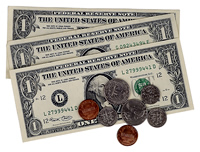Seventh Grade - Social Studies
Activities
Ute Leaders Influence Utah
Financial and Economic Concepts: Economic Reasoning Seventh Grade – Utah Studies
Seventh Grade – Utah Studies
Standard 2: Students will understand the contributions of Native American Indians, explorers, and Utah's pioneers.
Objective 1: Examine the contributions of Native American Indians to the culture of Utah.
 Time: 45 minutes
Time: 45 minutesMaterials: Computer and projector for movie clip, Handouts
This lesson helps students understand the influence of four important Ute leaders—Wakara, Black Hawk, Ouray, and Tabby-To-Kwanah. Each of these men courageously guided their people through difficult periods in Ute history, and their examples of leadership lends insight into the struggle of the Ute people as non-Indians took over their land. The Utes experienced real, day to day conflict that threatened their existing economic system. The students will use the information they learn about each leader to fill in a timeline of Ute history. Doing so will help them understand the important roles Ute Indians have played in the history of Utah. Have students watch the video clip, review the timeline background, and complete the worksheet. As a class, discuss the questions below.
![]() Video Clip: (5:36) "We Shall Remain: The Ute"
Video Clip: (5:36) "We Shall Remain: The Ute"
![]() Ute Leadership - At a Glance (pdf) - General information and background for the teacher.
Ute Leadership - At a Glance (pdf) - General information and background for the teacher.
![]() Ute Timeline (pdf) - Handout for students with specific details of Ute experiences.
Ute Timeline (pdf) - Handout for students with specific details of Ute experiences.
![]() Ute Timeline Worksheet (pdf) - Students fill this in while using Ute Timeline.
Ute Timeline Worksheet (pdf) - Students fill this in while using Ute Timeline.
![]() Discussion Questions (pdf) - Discuss as a class at the conclusion of the activity.
Discussion Questions (pdf) - Discuss as a class at the conclusion of the activity.
The Bartering System
Financial and Economic Concepts: Economic Reasoning Seventh Grade – Utah Studies
Seventh Grade – Utah Studies
Standard 2: Students will understand the contributions of Native American Indians, explorers, and Utah's pioneers.
Objective 3: Describe the significance of pioneers in Utah history.
 Time: 45 minutes
Time: 45 minutesMaterials: 3 one dollar bills. Students need to bring one $1 item from home to trade with others.
Pioneers had wants and needs in Utah in the 1840's, 50's, and 60's, but the lack of cash severely dampened the economy. The influx of even a little cash went a long way toward building Utah's economy. In this activity, students will participate in a bartering activity where they can experience the impact that cash had on early Utah settlers.
![]() Complete Lesson Plan - See Instructional Procedures
Complete Lesson Plan - See Instructional Procedures
Change for a $5?
Financial and Economic Concepts: Economic Reasoning Seventh Grade – Utah Studies
Seventh Grade – Utah Studies
Standard 2: Students will understand the contributions of Native American Indians, explorers, and Utah's pioneers.
Objective 3: Describe the significance of pioneers in Utah history.
 Time: 45 minutes
Time: 45 minutesMaterials: Dollar bill, Sand (preferably in a small pouch), Precise scales, paper and art supplies (optional)
Barter, or exchange of goods, was sufficient for early pioneer society, but it was not always convenient or practical. Furthermore, for obtaining needed supplies from the East it was worthless. To develop universally acceptable currency, Mormon leaders decided to mint gold coins, using gold dust from California. In this activity, students will experience why gold was not always the best medium of exchange.
![]() Complete Lesson Plan - See Instructional Procedures
Complete Lesson Plan - See Instructional Procedures
Servants of the Community
Financial and Economic Concepts: Charitable Giving Seventh Grade – Utah Studies
Seventh Grade – Utah Studies
Standard 2: Students will understand the contributions of Native American Indians, explorers, and Utah's pioneers.
Objective 3: Describe the significance of pioneers in Utah history.
Standard 6: Students will understand the impact of major contemporary events that concern the land and people of Utah.
Objective 1: Identify and investigate major contemporary events that affect individuals, institutions, and society.
 Time: 30 minutes longer if desired
Time: 30 minutes longer if desiredMaterials: Handouts
Community minded citizens can make a lasting difference. Everyone can serve their community in some way. This lesson will help students recognize that money is not the only way to give of themselves.
![]() Complete Lesson Plan - See Instructional Procedures
Complete Lesson Plan - See Instructional Procedures
How the Economy Works
Financial and Economic Concepts: Economic Reasoning Seventh Grade – Utah Studies
Seventh Grade – Utah Studies
Standard 4: Students will understand the diverse ways people make a living in Utah.
Objective 3: Examine aspects that have broadened Utah’s economy.
 Use the Scholastic News Online Special Report on the economy to help students understand both general economic terms and the roots of the current crisis.
Use the Scholastic News Online Special Report on the economy to help students understand both general economic terms and the roots of the current crisis.
![]() Student Workseet (pdf)
Student Workseet (pdf)
![]() Additional Resources - In this special collection, you'll find advice on how to talk to your students and ideas on how to incorporate this topic into your curriculum.
Additional Resources - In this special collection, you'll find advice on how to talk to your students and ideas on how to incorporate this topic into your curriculum.
Reflections on Charitable Contributions
Financial and Economic Concepts: Charitable Giving Seventh Grade – Utah Studies
Seventh Grade – Utah Studies
Standard 6: Students will understand the impact of major contemporary events that concern the land and people of Utah.
Objective 1: Identify and investigate major contemporary events that affect individuals, institutions, and society.
 Activity 1:
Activity 1:
Have students write an essay on a charitable event or activity they have been involved with or know about.
Activity 2:
Have students research Utah philanthropists (e.g., Jon M. Huntsman, James L. Sorenson, George S. and Delores Dore Eccles) and write about their lives and their contributions.


